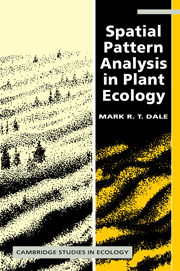Book contents
- Frontmatter
- Contents
- Preface
- 1 Concepts of spatial pattern
- 2 Sampling
- 3 Basic methods for one dimension and one species
- 4 Spatial pattern of two species
- 5 Multispecies pattern
- 6 Two-dimensional analysis of spatial pattern
- 7 Point patterns
- 8 Pattern on an environmental gradient
- 9 Conclusions and future directions
- Bibliography
- Glossary of abbreviations
- List of plant species
- Index
1 - Concepts of spatial pattern
Published online by Cambridge University Press: 04 December 2009
- Frontmatter
- Contents
- Preface
- 1 Concepts of spatial pattern
- 2 Sampling
- 3 Basic methods for one dimension and one species
- 4 Spatial pattern of two species
- 5 Multispecies pattern
- 6 Two-dimensional analysis of spatial pattern
- 7 Point patterns
- 8 Pattern on an environmental gradient
- 9 Conclusions and future directions
- Bibliography
- Glossary of abbreviations
- List of plant species
- Index
Summary
Introduction
The natural world is a patchy place. The patchiness manifests itself in many ways and over a wide range of scales, from the arrangement of continents and oceans to the alternation of the solid grains of beach sand and the spaces between them. Plants in the natural world also are patchy at a great range of scales from the global distributions of biomes to the arrangements of trichomes and stomata on the surface of a leaf. When the patchiness has a certain amount of predictability so that it can be described quantitatively, we call it spatial pattern. Although the concept of pattern is often associated with nonrandomness, in some cases we will want to allow the possibility of random pattern, because true randomness does permit a certain amount of prediction. As an illustration of spatial pattern, Figure 1.1 presents an example from the literature, a map of the patches of Calluna vulgaris (heather) in a 10m × 20m plot in central Sweden (redrawn from Diggle 1981). A transect through the vegetation, such as the one illustrated in the lower part of the figure, reveals a fairly regular alternation of patches of high density and gaps between them.
Pattern and process
The impetus to study spatial pattern in plant communities comes from the view that in order to understand plant communities, we should describe and quantify their characteristics, both spatial and temporal, and then relate these observed characteristics to underlying processes such as establishment, growth, competition, reproduction, senescence, and mortality.
- Type
- Chapter
- Information
- Spatial Pattern Analysis in Plant Ecology , pp. 1 - 30Publisher: Cambridge University PressPrint publication year: 1999
- 3
- Cited by



